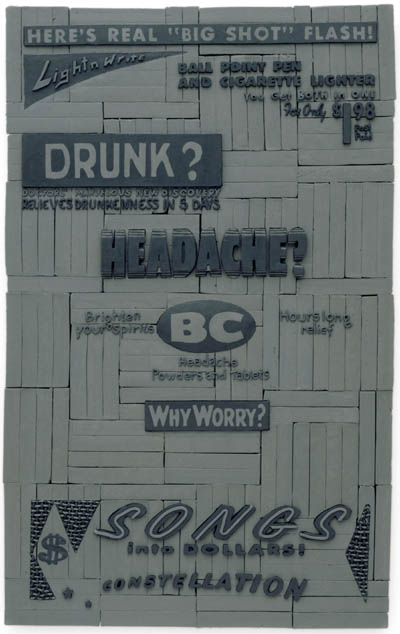 Light n Write, 2006 Plasticine, 89 x 55 cm © Ellen Gallagher Ellen Gallagher Salt Eaters Ellen Gallagher's art explores issues of race, identity and transformation. Renowned for her reworking of popular black imagery, Gallagher draws on postwar magazines and advertising, as well as film and music culture. She makes repeated reference to the traditions of minstrelsy, as well as to specific performers such as vaudeville star Bert Williams and jazz musician Sun Ra. Pages from mid-century black photomagazines such as Ebony, Our World and Sepia - all dominated by advertisements for Afro hairstyles, wigs and skin products aimed at African-American women - are often cited in her investigation of the anxieties and tensions surrounding black identity in the age of consumerism. Historically specific cultural references are merged with Gallagher's own personal biography as a black Irish American woman. Her imagery combines densely patterned surfaces in grid format with intricate biomorphic forms. On closer inspection, these are revealed to be accumulations of stylised eyes and mouths, signs drawn from the historical caricatures of the black body. Appropriating these stereotypical signifiers of identity, she subverts them by a meticulous process of repetition and revision, offering a new and poetic mode of representation. Gallagher's recent works display a particular fascination with the history of the islands of Cape Verde and their volcanic landscape that was for centuries the scene of trade in salt and slaves. Gallagher refers to the gathering of salt, the "white gold" upon which the Cape Verde communities were built. Her works are infused with a sense of alchemy. They reveal an interest in transformation, the process by which those who were forced to dig for salt and load ships slowly adopted the guise of their oppressors; a process whereby slaves, now proficient sailors and expert navigators, rose to become captains of weathered trading vessels. Multiple strands of meaning are woven into Gallagher's work, fusing this specific historical narrative with a personal perspective based on the artist's findings. This sense of metamorphosis extends to the techniques that Gallagher harnesses in her work. Though described as paintings, Gallagher's works are built up in layers of varied materials, including pen, pencil, paint, collaged paper and newsprint, oil, and plasticine. Her technique of production is intensely physical; the works are created over painstaking periods of time, their materials scored, scratched and gouged. Ellen Gallagher (b. 1965, Providence, Rhode Island) lives and works in New York and Rotterdam. Gallagher's work will be shown at the Institute of Contemporary Arts, London, as part of the forthcoming exhibition "Alien Nation". This summer, her film "Murmur" will be shown at Art Basel Unlimited. Already this year, Gallagher's work has been included in the critically acclaimed exhibition "Infinite Painting", curated by Francesco Bonami at Villa Manin, Italy. In March 2006, Gallagher's "DeLuxe" was shown at Hauser & Wirth Zurich. Other recent solo museum exhibitions include: "DeLuxe", Whitney Museum of American Art, NY (2005); "Murmur and DeLuxe", MOCA, Miami (2005); and "Ichthyosaurus", The Freud Museum, London (2005). Gallagher studied at Oberlin College, OH (1982-84); Studio 70, Fort Thomas, KY (1989); School of the Museum of Fine Arts, Boston, MA (1992); and at Skowhegan School of Art, ME (1993). In 2000 she was awarded the American Academy Award in Art and in 2003 was selected for the Venice Biennale. Exhibition June 7 - July 22, 2006 Gallery hours Tues-Sat 10 am - 6 pm Hauser & Wirth London 196A Piccadilly GB-London W1J 9DY Telephone +44 20 7287 2300 Fax +44 20 7287 6600 Email london@hauserwirth.com www.hauserwirth.com |